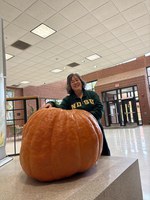Dakota Gardener: Five things you didn’t know about pumpkin
(Click an image below to view a high-resolution image that can be downloaded)
-

Esther McGinnis, NDSU Extension horticulturist, stands next to a giant pumpkin on the NDSU campus, and shares some little-known facts about pumpkin in this week's Dakota Gardener. (NDSU photo) -

Esther E. McGinnis, NDSU Extension horticulturist (NDSU photo) -

Dakota Gardener graphic identifier (NDSU photo)
By Esther E. McGinnis, Horticulturist
NDSU Extension
We are in the waning days of pumpkin season. I’ve consumed pumpkin spice lattes, cake and even lager. Now, we are looking forward to Thanksgiving and eating pumpkin pie. Before we transition to eggnog and candy canes, let’s celebrate all things pumpkin with some little-known facts.
- Pumpkin is a fruit. Technically, pumpkin, squash, zucchini and cucumber are all botanical fruits because they developed from a pollinated flower and contain seeds. From a cook’s viewpoint, pumpkin is hard to definitively classify as a vegetable or fruit because it can be prepared either as a sweet dessert or a savory dish such as soup.
- All pumpkin varieties are squash but not all squash are pumpkins. Squash is a broader category that encompasses three or four commonly grown species in the Cucurbita genus. The term, pumpkin, is based on its appearance and traditionally refers to a ribbed squash that is usually round and orange. However, white, green, gray and blue pumpkins exist if you like a more novel appearance.
- Canned pumpkin that we use in our pies may not technically be from a true pumpkin. The FDA allows commercial canners to pack squash (or a mixture of squash and pumpkin) and label it as pumpkin.
- Pumpkin and squash are old. Archeologists studying fossilized dung discovered that North American mastodons and woolly mammoths ate small squashes. This was a mutually beneficial relationship because these large mammals transported the seeds to new areas and excreted them with a generous amount of fertilizer. This gardening relationship sadly ended with the mastodon and mammoth extinction. Fortunately, for squash and pumpkin, humans took an interest in the fruit, first for its storage qualities. Archeological evidence shows the first signs of human domestication 10,000 years ago in Mexico and other regions. Humans first came to appreciate the nutritious seeds. Eventually, indigenous peoples started selecting fruits with sweeter-tasting flesh and cultivating the seeds.
- Squash played an important role in regional agricultural history. The Mandan, Hidatsa and Arikara peoples practiced the four sisters gardening method which was described by Buffalo Bird Woman, also known as Maxidiwiac. This method included planting corn to grow vertically to provide support for pole beans. In exchange, the beans produced nitrogen for the corn. Squash leaves covered the ground to shade out weeds and to retain soil moisture. The fourth sister, a row of sunflowers, provided a windbreak to the north and attracted pollinators. Arikara squash and Mandan green and white squash seeds are available for those who want to grow a bit of history.
- Finally, the earliest pumpkin pies were served without a crust. The seeds were extracted and the pumpkin shells were filled with a mixture of spiced milk and honey. The whole fruit was then roasted in a fire.
I hope you have a renewed appreciation for your pumpkin pie.
NDSU Agriculture Communication – Nov. 5, 2025
Source: Esther McGinnis, 701-231-7406, esther.mcginnis@ndsu.edu
Editor: Kelli Anderson, 701-231-6136, kelli.c.anderson@ndsu.edu

